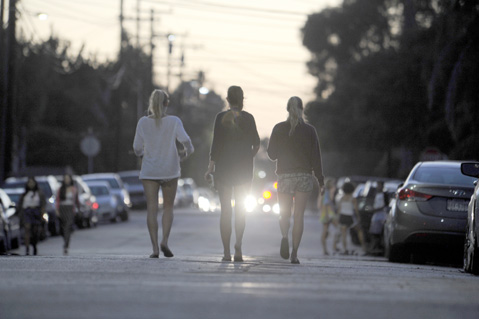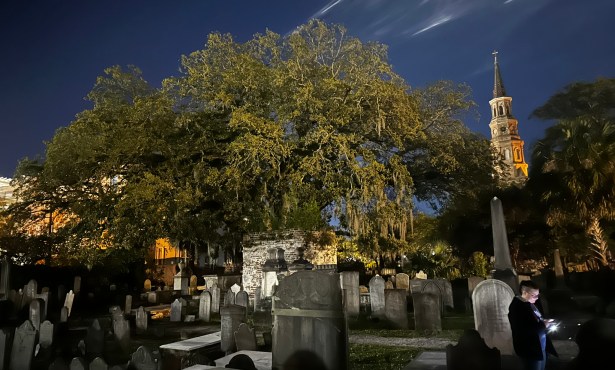Isla Vista’s Transportation Jungle
A Chaotic and Tricky Urban Planning Problem

Cars crossing Pardall Road at Embarcadero del Norte at about 10 a.m., 11 a.m., and noon on a school day face the very distinct possibility of waiting two or three minutes before the torrential two-way stream of cyclists abates enough for their drivers to move on from the stop signs. Riders on MTD’s Line 27 often face a jam-packed bus ride through Isla Vista. Residents living in the west half of I.V. looking for parking after sundown may find themselves having to trek a couple long blocks back to their home or apartment.
For such a tiny area, I.V. is bustling with a wide array of modes of transportation. Cars take residents to work, into Santa Barbara, and, for students, back to their hometowns; bikes and ambulation get them to class, a friend’s house, or out to eat. Scooters and rollerblades aren’t uncommon sights, and a few different party buses routinely ferry clubbers to and from downtown Santa Barbara.
According to the county’s Isla Vista Master Plan, “on average, nearly 36,000 automobiles, 15,000 bicycles, and 8,000 pedestrians enter or leave Isla Vista each day” — in a town of 23,000. Though three-quarters of I.V.’s sizeable undergraduate population bikes at least “sometimes,” according to UCSB’s Annual Transportation Survey, 80 percent of adult residents still own a car.
I.V.’s well-known transportation issues revolve primarily around its saturated parking situation. With the limited number of services and jobs in town for thousands of apartment-dwelling students whose permanent residences are far from their university, cars have become a mainstay in I.V., and their accommodation has increasingly become the focus of infrastructure improvement talks. Apartment complexes routinely charge tenants hundreds of dollars to use their parking spaces, and the past year’s crackdown on cars in driveways extending out onto sidewalks has exacerbated the community’s crammed curbs. Though a 2013 survey by Fehr & Peers Transportation Consultants presented last September by the county’s Planning and Development agency claimed that I.V. has a parking vacancy rate of at least 15 percent, it was met with fierce disagreement by residents offering first-hand testimony in favor of a much smaller rate.
The extremely detailed and exhaustive I.V. Master Plan, originally adopted in 2007 as the community’s urban planning guide, lays out perhaps the most ambitious goals around for improving and overhauling the community’s hectic and overcrowded transportation scene. In order to mitigate residents’ dependence on cars and ease the strain on stowing them, the plan proposes such measures as permit and metered parking and the encouragement of a ride-sharing program. Roundabouts, a bike boulevard on residential Sueno Road, and filling in the town’s yawning gaps in its sidewalks and crosswalks are proposals for making safer the free-for-all mingling of bikes, skateboards, cars, and pedestrians. Because of the steep costs and sheer inconvenience of implementing many of its ambitious policies, however, the realization of the Master Plan’s proposals hasn’t exactly kept up with the scope and ambition of their goals.
Should Isla Vistans approve the community service district (CSD) on their ballots this year, though, the first concrete steps to alleviating the seemingly hopeless parking situation may be in the works. The CSD will have the power to establish a parking district (assuming LAFCO ultimately grants it this power). The ability and funding to maintain and improve I.V.’s ailing transportation infrastructure and tailor it to its safety and circulation needs will be a step toward making its streets less chaotic and more conducive to active modes of transportation.
Other, already-extant local organizations are looking to make a difference, too. The UCSB Associated Students Bike Committee focuses in large part on educating students about biking safety and the relevant laws. The recently formed Isla Vista Downtown Business Association held a meeting January 7 with local law enforcement, the county Public Works Department, and UCSB representatives to discuss improving traffic safety.
In addition to infrastructure deficiencies, says bike committee chair Tiffany Wu, “the tradition and culture of biking” also requires attention and modification — a conclusion attendees at I.V.’s Business Association meeting came to as well. A key to making safer, say, the Pardall rush hours is to hammer home safe biking education, but in a context and manner that would draw in and appeal to the student-dominated population.
Both organizations have begun collaborating, says Wu, to improve the parking situation and tackle the often-Frogger-like scene on Pardall Road. As with most structural change in I.V., easing the community’s transportation stresses will likely have to come from the ground up.



